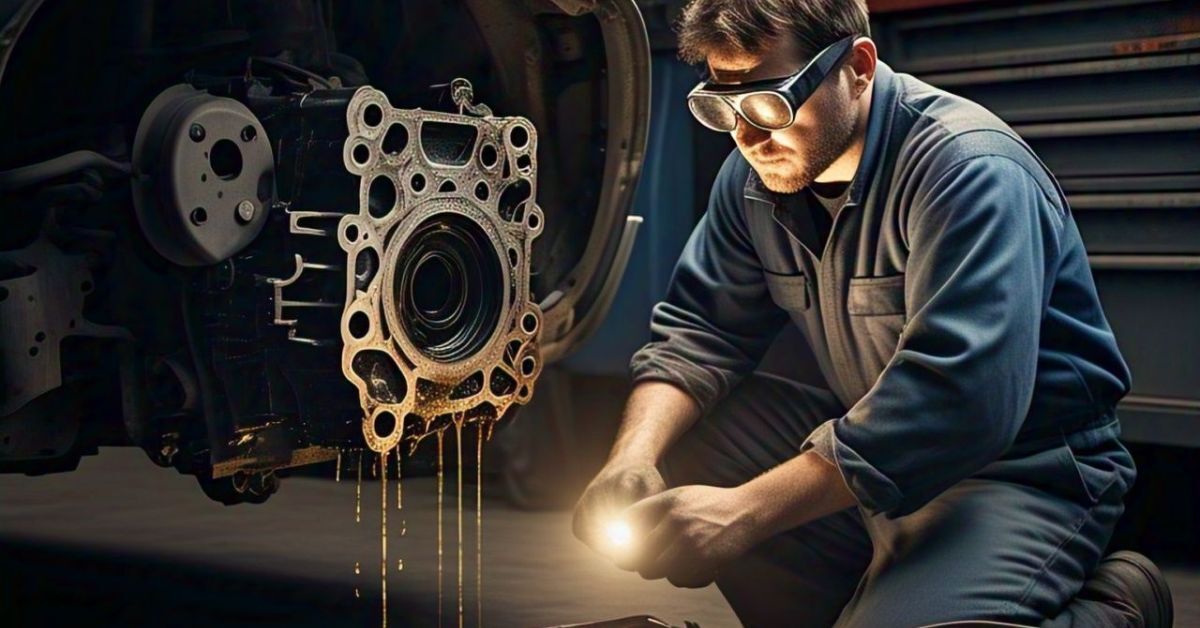One of the most annoying and expensive automotive issues a car owner may have is a rear main seal leak. This problem arises when the rear main seal, which closes off the area where the crankshaft leaves the engine block and is situated at the back of the engine, starts to fail. Oil spills from the engine as a result, which could seriously harm the car.
We will examine the causes, signs, and fixes for rear main seal leaks in this extensive tutorial. This article will give you all the knowledge you require, regardless of whether you’re a mechanic, an automobile owner, or someone who wants to learn more about this prevalent problem.
What Is a Rear Main Seal and Why Does It Matter?
The rear main seal is a vital component in your vehicle’s engine system. It serves as a seal between the engine block and the crankshaft, preventing engine oil from leaking out of the rear of the engine. This seal plays an essential role in maintaining proper oil pressure and preventing contaminants from entering the engine.
The crankshaft is a key part of the engine that transfers power from the pistons to the rest of the drivetrain. As the crankshaft turns, it moves the rear main seal to keep the engine oil contained within the engine block. Without this seal, oil would leak from the engine, potentially leading to low oil levels and causing long-term damage to critical components such as the pistons, cylinders, and bearings.
Causes of a Rear Main Seal Leak
Several factors can contribute to a rear main seal leak. Understanding these causes can help you identify the root of the problem more quickly.
1. Wear and Tear
Over time, the rear main seal can simply wear out due to constant exposure to heat, pressure, and oil. Like any rubber or gasket material, the seal can break down and lose its elasticity. As it loses its ability to stretch and return to its original form, the seal begins to crack and leak.
2. Age of the Vehicle
As vehicles age, the rear main seal may degrade faster. Older vehicles that have been through high mileage or extreme temperatures may experience seal failure more frequently. The deterioration is accelerated by prolonged exposure to engine heat, making it a common issue in older cars.
3. Incorrect Installation
If the rear main seal was improperly installed during assembly or repair, it could be more prone to failure. Poor installation can result in an improper seal, leading to leaks. This can happen during manufacturing, but it’s more common in vehicles that have undergone engine repair work.
4. Engine Overheating
If your engine has experienced overheating, it could be a direct cause of rear main seal failure. When the engine runs hotter than normal, it can cause the seal to warp and lose its ability to hold the oil inside the engine. The increased heat breaks down the material of the rear main seal, accelerating its wear.
5. Excessive Oil Pressure
Oil pressure that is too high can put undue stress on the rear main seal. If the oil pump is malfunctioning or the engine is running too rich, it can lead to higher oil pressure. The rear main seal is designed to withstand only a certain level of pressure. Excessive pressure will cause it to fail over time.
6. Contamination
If the engine oil becomes contaminated with dirt, debris, or other impurities, it can cause the rear main seal to deteriorate faster. These contaminants can damage the seal’s surface, leading to cracks and leaks.
7. Improper Oil Levels
Running the engine with either too little or too much oil can affect the rear main seal. Low oil levels can cause increased friction in the engine, while high oil levels can increase pressure and contribute to seal failure.
Symptoms of a Rear Main Seal Leak
Detecting a rear main seal leak early can help prevent major engine damage. Here are some common signs of a leaking rear main seal:
1. Oil Spots Under the Car
One of the most obvious signs of a rear main seal leak is noticing oil spots or puddles underneath your car. The oil typically drips from the rear of the engine, often near the transmission or where the engine meets the transmission. However, keep in mind that oil leaks can also occur from other areas, so it’s important to pinpoint the source.
2. Low Oil Levels
If you frequently need to top off your oil, it could be a sign of a rear main seal leak. Oil leaking from the rear main seal can result in a slow, but consistent, drop in oil levels. If left unchecked, this can lead to serious engine problems.
3. Burning Oil Smell
If the oil drips onto hot components of the engine, such as the exhaust manifold, you may notice a burning oil smell. This occurs because the oil is heated to a high temperature and burns as it comes into contact with the engine’s hot parts.
4. Engine Misfires or Poor Performance
A low oil level resulting from a rear main seal leak can lead to a decrease in engine lubrication, causing the engine to run poorly. Symptoms such as engine misfires, rough idling, or hesitation when accelerating may indicate that the oil levels are low or the engine is running dry.
5. Clutch Slippage (Manual Transmission)
If your vehicle has a manual transmission and is experiencing rear main seal failure, you may notice clutch slippage. Oil leaking from the rear main seal can find its way onto the clutch disc, reducing friction and causing slippage. This leads to poor clutch engagement and difficulty shifting gears.
How to Fix a Rear Main Seal Leak
Fixing a rear main seal leak is a complicated process, and depending on the severity of the leak, it may require significant repairs. Here are the primary options for fixing a rear main seal leak:
1. Replacement of the Rear Main Seal
The most effective way to fix a rear main seal leak is to replace the seal. However, replacing the rear main seal is labor-intensive and may involve removing the transmission, flywheel, and other components. This repair is best suited for professional mechanics due to the complexity and time it requires.
2. Sealant Products
In some cases, you may be able to use an oil sealant or stop-leak additive to temporarily fix a rear main seal leak. These products work by softening and expanding the rubber of the seal, potentially filling in small cracks and reducing oil leakage. However, this is only a short-term fix and should not be relied upon for long-term results.
3. Engine Rebuild or Replacement
In extreme cases, a full engine rebuild or replacement may be necessary, especially if the rear main seal has caused significant damage to the engine components. This is usually a last resort when other repair methods are no longer viable.
Prevention and Maintenance Tips
While some rear main seal leaks are inevitable due to aging or wear, there are several ways to extend the life of your rear main seal and minimize the chances of a leak occurring:
1. Frequent Oil Changes: To maintain seal lubrication and avoid contamination, change the engine oil on a regular basis. Always use the type and viscosity of oil that the manufacturer recommends.
2. Verify Oil Pressure: Make sure the right oil pressure is present in your engine. To stop additional damage, get the problem fixed right away if you see an oil pressure warning light or fluctuating pressure.
3. Monitor Engine Temperature: Take care of any overheating problems to maintain a healthy engine temperature. The rear main seal may experience needless stress if the engine is operating too hot.
4. Check for Leaks: Keep an eye out for indications of oil leaks in your car’s underside. To stop additional harm, take care of any problems as soon as you see them.
5. Refrain from Overloading your Car: Carrying too much weight or towing might put additional strain on the engine, raising the risk of rear main seal failure.
Rear Main Seal Leak: Quick Comparison
| Cause | Symptom | Fix | Preventive Measure |
| Wear and Tear | Oil spots under the car | Replace rear main seal | Regular oil changes |
| Age of Vehicle | Low oil levels | Replacement of the seal | Regular maintenance checks |
| Incorrect Installation | Burning oil smell | Professional inspection | Professional installation |
| Engine Overheating | Engine misfires | Replace seal & inspect engine | Keep engine cool and maintained |
| Excessive Oil Pressure | Clutch slippage (manual) | Replace seal & check pressure | Proper oil pressure maintenance |
| Contamination | Low engine performance | Replace seal | Use high-quality oil |
| Improper Oil Levels | Engine running poorly | Replace seal | Maintain proper oil levels |
This chart offers a quick reference to help identify the causes, symptoms, and solutions for a rear main seal leak, along with useful preventive tips to avoid this issue in the future.
Conclusion
A rear main seal leak is a significant issue that can lead to costly repairs if not addressed promptly. Recognizing the symptoms, understanding the causes, and taking preventive measures can help car owners avoid the inconvenience of dealing with this problem. Whether you opt for a professional repair or a temporary sealant fix, it’s essential to stay vigilant and ensure that your engine is properly maintained.
By following the advice and tips outlined in this guide, you can prevent rear main seal leaks and ensure the longevity of your engine. Remember that if you’re not confident in your ability to perform repairs, it’s always best to consult a professional mechanic to ensure the job is done correctly.







